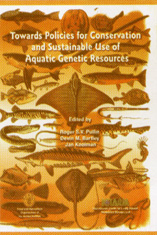Tave, D. 1999. Inbreeding and brood stock management. FAO Fisheries
Technical Paper. No. 392. Rome, FAO. 122 pp.

This manual, written for extension workers, aquaculturists, and
those who work with natural resource m a n a g e m e n t
programmes, primarily deals with the problems caused by unwanted inbreeding in cultured
fish populations and describes management techniques that can be used to prevent or
minimize inbreeding.
The manual also describes how inbreeding can be used to improve
captive populations of fish. The manual contains chapters on: basic genetics and the
genetics of inbreeding; how to determine individual inbreeding values when pedigrees are
known; how to determine the average inbreeding value in a population when pedigrees are
not known; genetic drift, which is random changes in gene frequency; how inbreeding
programmes can be used to improve cultured populations of food fish; how to prevent
inbreeding depression and loss of genetic variance in farmed populations; and
recommendations on how to manage cultured populations of fish to prevent unwanted
inbreeding and genetic drift from depressing productivity, profits, and survival.
One of the most important aspects of managing a closed population offish at a fish farm or
fish culture station is the management of the population's effective breeding number,
because inbreeding is inversely related to the effective breeding number.
Techniques to determine and manage the effective breeding number are described, and
recommended mininum effective breeding numbers are provided for a variety of farm sizes
and fish culture goals. A number of culture techniques can affect inbreeding, and ways to
modify them so there is minimal impact on inbreeding are discussed. Finally, ways to
minimize inbreeding during selective breeding programmes are described.
Pullin, R.S.V., D.M. Bartley and J.Kooiman, Editors. 1999. Towards policies for conservation and sustainable use of aquatic genetic resources. ICLARM Conf. Proc. 59, 277pp.

FIRI is pleased to announce the publication,
Towards policies for conservation and sustainable use of aquatic genetic resources, edited
by R.S.V. Pullin, D.M. Bartley and J. Kooiman (ICLARM Conference Proceedings 59, 1999).
The publication represents the proceedings from the ICLARM/FAO Bellagio Conference held in
Bellagio Italy, 14 to 18 April 1998. As Dr Louise Fresco, currently Assistant Director
General of the Agriculture Department FAO states in the Foreword to the proceedings,
"... the development of sound policies governing the use of aquatic genetic resources
has, in general, lagged behind the impressive technical developments . ... this volume
represents one of the first efforts at bringing together the diverse information necessary
for the development of policies for the sustainable use and conservation of aquatic
genetic resources." The proceedings include a wide range of disciplines, such as
aquatic biology, aquaculture, population genetics, fish breeding, governance of natural
resources, fisheries, public awareness, intellectual property rights, and law, that will
all play a role in policy formulation. For information on how to order please contact
Devin M. Bartley ([email protected]) or ICLARM Publication Unit Manager PO BOX 500,
GPO, 10670
Penang, MALAYSIA ([email protected]).

